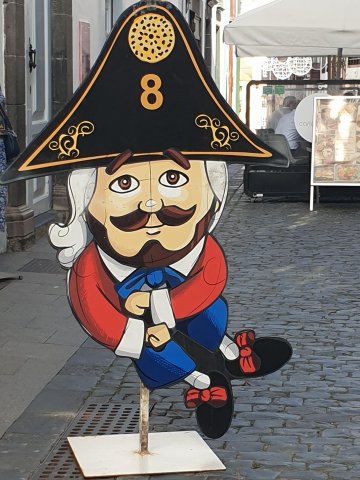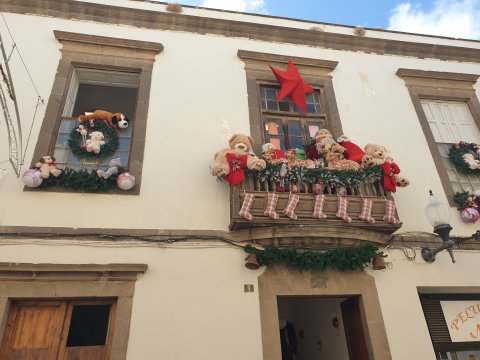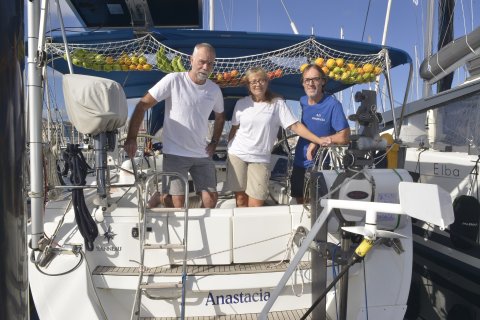
After the visit to Fuerteventura, we set off towards the southern tip of Gran Canaria to meet the Åkerlund family from Trollhättan, who were at Meloneras. We therefore sailed to the adjacent beach of Pasito Blanco to visit them. We also recognized the boat Black Pearl of Sweden https://www.facebook.com/BlackPearlofSwedentobecontinued that was anchored in the same bay as Anastacia. There we spoke with Svante who, together with his wife Sanna, "long time-sailed" for 7 years, mainly in the Canary Islands. Svante knew a lot about the archipelago and gave us valuable tips about good anchorages, sights and where the infamous so-called acceleration zones were, where the wind is squeezed between the islands and can reach up to double its strength. At the adjacent port we later met Eva and Mats on S/Y Angelina. Experienced sailors who have been to the Caribbean before and who gave us a lot of good advice for our continued sailing. We also took the opportunity to celebrate our wedding anniversary at a nice restaurant nearby. Well replenished after all the social activities, we decided it was time to sail on. We wanted to have time to visit Tenerife before we "park" the boat on the island of La Palma. Hopefully we will have the opportunity to explore Gran Canaria later in December when we gather in Las Palmas with all the sailors who, like us, will set off across the Atlantic with the Viking Explorers Rally 2024.
We made the crossing to Tenerife at night to arrive early, the next day. We reefed the mainsail early since we expected an increase in wind between the islands. The wind came as anticipated and Anastacia topped out at 9 knots, when we reached the acceleration zone, then the boat became more difficult to steer due to the high waves and it started to rattle quite a bit among the china in the cupboards. I (Malin), who had my night shift, woke Christer up - it was time to set the next reef...A few hours later (and two wine glasses lesser) we reached the southwest side of Tenerife and anchored at the sheltered beach of Los Cristianos. Then I fell asleep and didn't wake up until late afternoon. Christer had instead had a great day in the boat and had been tinkering in peace until I got up 😊
The next day we were to pick up the car we booked online. When we arrived at the rental office, in a fenced parking area, a young and somewhat anxious guy at the rental company stated that the car we booked was not there! He couldn't understand how we managed to book it and talked non-stop to his manager on the phone. They offered us another car which was 30 EUR more expensive. We felt a bit “tricked” but managed to get the price down slightly on the new car, after talking to the manager. We didn't have much choice. We really needed a car to get around the island.
We immediately set course for the Teide volcano. Tenerife is perhaps best known for the volcano which had its last major eruption in 1909. A few small eruptions have occurred since then from adjacent craters. Teide is the world's third largest volcano with its approx. 3,700 m high above sea level, but if you count from the base of the volcano, under the sea, it is a total of 7,500 m high! The people of Tenerife themselves are proud that Teide is Spain's highest mountain 😊. The entire area is now part of a national park and is considered a world heritage site. On the way up we saw several areas that had been ravaged by fire but where many of the special pine trees that grow on the islands seemed to have been able to withstand it relatively well. We drove as high as we could, up to the cable car which is located at an altitude of 2,300 m and which takes the visitors further over 1,000 m towards the top. To get to the very top of the crater, a permit is required and you can only get there on foot. We refrained from the cabin track tour, already very satisfied with the magnificent views we got to enjoy on the way up. Not least the feeling of being above the clouds! Next to Teide is also the famous Teide Observatory, which is one of the world's largest space (and solar) observatory. Unfortunately, we missed the opportunity to get a guided tour. There was only one ticket left when we tried to book and neither of us wanted to experience the observatory without the other... Hopefully we'll get another chance later.
The next stop was in the beautiful coastal town of Porto de la Cruz and its man-made pool and recreation area "Lago Martiánez" designed by César Manrique, the famous architect, artist and environmentalist from Lanzarote we told you about earlier. It was easy to recognize his style with white walls and facades and works of art scattered across the area. In Porto de la Cruz, there are also natural saltwater pools half-sheltered from the sea where the ocean waves constantly break in and contribute new water.
South of Porto de la Cruz is Icod de los Vinos. In itself perhaps not a remarkable place, but the fantastic thing here is the "thousand-year-old tree". A living Canarian Dragon Tree from around the year 1000, whose growing site now forms a botanical garden with examples of trees and other plants typical of the island. One cannot help but think about how much this tree must have seen and been a part of!
In the area there is also a reconstruction of lava tunnels that were used as shelter/habitation and sometimes burial sites of the indigenous people here called Guanche. The Guanche belong to the same people as on other islands originating from North Africa (compare Fuerteventura's Machos). The Guanche lived near the volcanoes on Tenerife and it is believed that they considered Teide to be the entrance to the underworld/hell where certain gods were held captive.
The last place we managed to visit on our tour was the small village of Macos. To get there we had to drive a very narrow road that wound its way up a mountain. Once there, we could see the village where the inhabitants, who number only about a hundred, had built their houses on the ridges. This was also a historical site where a group of Guanche are said to have lived. Unfortunately, we didn't have time to visit the museum, which had more to show about the place and the indigenous population, but we could in any case be amazed at how beautiful and dramatic the landscape was!
Before dark we were eventually able to return the car to its parking lot in Los Cristianos. Little did we know then what a mistake this was!
The next morning, we got ready to head north along the west coast of Tenerife for further sailing towards La Palma. Just before we set off, Christer's phone started ringing non-stop. He had received about ten messages from the guy at the car rental company who wanted us to pay another 20 EUR for parking the car at their office - otherwise he risked being fired! In order not to continue with a lot of exchange of arguments via WhatsApp, we decided to go to the rental office again. Once there, we found out that the company had no parking spaces for the cars in Los Cristianos, but you were expected to park in free parking lot in the city, as it would otherwise cost 20-40 EUR to leave the car in the fenced area by the office. The guy who staffed the office here had to take care of the parking problems himself by driving the rental cars around town until he found an available free spot - before the customers arrived. He had to pay any parking fees himself. We thought it was a strange system and suggested other companies that seemed more professional where he could look for a job. After paying for our parking, we set off.
The next anchorage where we stayed overnight was outside the village of Macos we had visited the day before. Now we could see the breathtaking vertical mountains from the sea side and here you could clearly see the entrances to the small caves. You could also see on some mountain walls how the hot lava, during a late lava eruption, had flowed over the edge and dripped down the steep ravines towards the water. Christer likened the whole thing to pouring custard over a piece of apple pie. A completely correct description that could have been found in any scientific geology journal! 😊
Now we have left Tenerife and are bobbing on towards La Palma. As I write this, we are watching a partial lunar eclipse unfold in the night sky. At dawn we expect to arrive in La Palma. There we will leave the boat and travel to Sweden for a few weeks. The adventure continues when we get back…
~~~~~~~~~~~~
Efter besöket på Fuerteventura gav vi oss av mot Gran Canarias sydspets för att träffa familjen Åkerlund från Trollhättan som befann sig på Meloneras. Vi seglade därför till den intilliggande stranden Pasito Blanco för att besöka dem. Vi kände också igen båten Black Pearl of Sweden https://www.facebook.com/BlackPearlofSwedentobecontinued som låg ankrad i samma vik som Anastacia. Där pratade vi med Svante som, tillsammans med frun Sanna, ”längeseglat” i 7 år, främst vid Kanarieöarna. Svante kunde massor om ögruppen och gav oss värdefulla tips om bra ankringsplatser, sevärdheter och var de ökända s k accelerationszonerna var, där vinden pressas mellan öarna och kan nå upp till sin dubbla styrka. Vid den intilliggande hamnen träffade vi senare Eva och Mats på S/Y Angelina. Erfarna seglare som varit i Karibien tidigare och som gav oss många bra råd inför vår fortsatta segling. Vi passade också på att fira vår bröllopsdag på en trevlig restaurang i närheten. Rejält påfyllda efter alla sociala aktiviteter bestämde vi oss för att det var dags att segla vidare. Vi ville gärna hinna besöka Teneriffa innan vi ”parkerar” båten på ön La Palma. Förhoppningsvis får vi tillfälle att utforska Gran Canaria senare i december när vi samlas på Las Palmas med alla seglare som, liksom vi, skall ge sig av över Atlanten med Viking Explorers Rally 2024.
Vi gjorde överseglingen till Teneriffa på natten för att hinna fram tidigt, nästa dag, Vi revade tidigt eftersom vi räknade med en vindökning mellan öarna. Vinden kom som förväntat och Anastacia toppade farten med 9 knop, när vi nådde accelerationszonen, sedan blev båten mer svårstyrd p g av de höga vågorna och det började slamra lite väl mycket bland porslinet i skåpen. Jag (Malin), som hade mitt nattpass, väckte Christer - det var dags för att sätta nästa rev… Några timmar senare (och två vinglas fattigare) nådde vi sydvästra sidan av Teneriffa och ankrade vid den skyddade stranden vid Los Cristianos. Sedan somnade jag och vaknade inte förrän sen eftermiddag. Christer hade istället haft en toppendag i båten och hade pysslat i lugn och ro fram till att jag stod upp 😊
Nästa dag skulle vi hämta bilen vi bokat på nätet. Väl framme vid uthyrningskontoret, i ett inhägnat parkeringsområde, konstaterade en ung och lite förskräckt kille på uthyrningsfirman att bilen vi bokat inte fanns! Han kunde inte begripa hur vi lyckats boka den och pratade oavbrutet med sin chef i telefonen. De erbjöd oss en annan bil som var 30 EUR dyrare. Vi kände oss lite lurade men lyckades få ner priset något på den nya bilen, efter samtal med ”chefen”. Vi hade inte så stort val. Vi behövde ju verkligen bil för att ta oss runt på ön.
Vi satte genast kursen mot vulkanen Teide. Teneriffa är kanske mest känd för vulkanen som hade sitt senaste stora utbrott 1909. Några små utbrott har skett därefter ur intilliggande kratrar. Teide är världens tredje största vulkan med sina ca 3 700 m hög över havet men räknar man från vulkanens botten, under havet, är den totalt 7 500 m hög! Teneriffaborna själva stoltserar med att Teide är Spaniens högsta berg 😊. Hela området ingår numera i en nationalpark och räknas som världsarv. På vägen upp såg vi flera områden som brandhärjats men där många av de speciella tallarna som växer på öarna verkade ha kunnat stå emot relativt bra. Vi körde så högt upp vi kunde, fram till kabinbanan som ligger vid 2 300 m höjd och som tar besökarna ytterligare över 1000 m mot toppen. För att komma till själva toppen på kratern krävs tillstånd och dit kan man bara komma till fots. Vi avstod från kabinbaneturen, redan mycket nöjda över de storslagna vyerna vi fått ta del av på vägen upp. Inte minst känslan att befinna sig ovan molnen! Intill Teide finns också den berömda Teide Observatory som är ett av världens största rymd- (och sol)observatorier. Tyvärr missade vi möjligheten att få en guidad tur. Det fanns bara en biljett kvar när vi försökte boka och ingen av oss ville uppleva observatoriet utan den andre… Förhoppningsvis får vi en ny chans senare.
Nästa stopp blev i den vackra kuststaden Porto de la Cruz och dess konstgjorda pool- och rekreationsområde ”Lago Martiánez” som designats av César Manrique, den kände arkitekten, konstnären och miljökämpen från Lanzarote vi berättat om tidigare. Det var lätt att känna igen hans stil med vita murar och fasader samt konstverk utspridda över området. I Porto de la Cruz finns också naturliga saltvattenspooler halvt avskärmade från havet där havsvågorna hela tiden bryter in och bidrar med nytt vatten.
Söder om Porto de la Cruz ligger Icod de los Vinos. I sig kanske ingen märkvärdig ort men det fantastiska här är det ”tusenåriga trädet”. Ett levande drakblodsträd från runt år 1000, vars växtplats numera utgör en botanisk trädgård med exempel på träd och andra växter som är typiska för ön. Man kan inte låta bli att fundera på vad mycket detta träd måste ha sett och varit med om!
I området finns också en rekonstruktion av lavatunnlar som använts som skydd/boende samt ibland gravplatser av ursprungsbefolkningen som här kallas Guanche. Guanche hör till samma folkslag som på övriga öar med ursprung från Nordafrika (jämför Fuerteventuras Machos). Guanche levde nära vulkanerna på Teneriffa och man tror att de bl a ansåg Teide vara ingången till underjorden/helvetet där vissa gudar hölls fångna.
Sista platsen vi hann med på vår rundtur var den lilla byn Macos. För att ta oss dit fik vi köra en mycket smal väg som gick slingrade sig uppför ett berg. Väl framme kunde vi se byn där invånarna, som bara uppgår till ett hundratal, byggt sina hus på bergskammarna. Detta var också en historisk plats där en grupp Guanche sägs ha levt. Tyvärr hann vi inte med att besöka muséet som hade mer att visa om platsen och ursprungsbefolkningen men vi kunde i alla fall häpna över hur vackert och dramatiskt landskapet var!
Innan det blev mörkt kunde vi så småningom lämna tillbaka bilen på dess parkering i Los Cristianos. Föga visste vi då om vilket misstag detta var!
Nästa morgon gjorde vi oss klara för att ta oss norrut längs Teneriffas västkust för vidare segling mot La Palma. Strax innan vi gav oss iväg började det plinga oavbrutet i Christers telefon. Han hade fått ett tiotal meddelanden från killen på biluthyrningsfirman som ville att vi skulle betala ytterligare 20 EUR för att vi ställt bilen på parkeringen vid deras kontor -annars riskerade han sparken! För att inte hålla på med en massa ordväxling via WhatsApp beslöt vi oss att ta oss till uthyrningskontoret igen. Väl framme fick vi reda på att firman inte hade några parkeringsplatser för bilarna i Los Cristianos utan man förväntades parkera på lediga parkeringar i staden då det annars kostade 20-40 EUR att låta bilen stå i det inhägnade området vid kontoret. Killen som bemannade kontoret här fick själv ombesörja parkeringsproblemen genom att cirkulera med uthyrningsbilarna runt i staden tills han hittade en ledig gratisplats - innan kunderna kom. Ev. avgifter fick han betala själv. Märkligt system tyckte vi och tipsade om andra firmor han kunde söka jobb på som verkade mer seriösa. Efter att ha betalat vår parkering gav vi oss iväg.
Nästa ankringsplats där vi låg en natt var på utsidan av byn Macos vi hade besökt dagen innan. Nu kunde vi se de hisnande lodräta bergen från havssidan och här såg man tydligt ingångarna till de små grottorna. Man kunde också på vissa bergsväggar se hur den heta lavan, vid ett sent lavautbrott, runnit över kanten och droppat ner för de branta ravinerna mot vattnet. Christer liknade det hela som när man häller vaniljsås över äppelpaj. En helt korrekt beskrivning som hade platsat i vilken vetenskaplig geologitidskrift som helst! 😊
Nu har vi lämnat Teneriffa och guppar vidare mot La Palma. Precis när jag skriver detta så ser vi hur en partiell månförmörkelse utvecklas på natthimlen. Vid gryningen räknar vi att komma fram till La Palma. Där lämnar vi båten och åker till Sverige under några veckor. Äventyret fortsätter när vi kommer tillbaks…
Teide and it's different surroundings










Observatorio del Teide


Porto de la Cruz






Millennial tree, baby Dragon Tree and Canarian Palm Tree





Reconstruction of lava tunnels



Village Macos. View from land and sea

































2 Commentaire(s)
Excellent författare, fina bilder, så kul att ni träffDe Svante oxå, det är ju inte varje dag man träffar nästan grannar från Blåsut på havet.
29 October 2023 AnswerTack Sven 😊 Det finns fler Vänersborgare där ute på vattnet 😁
29 October 2023 Answer